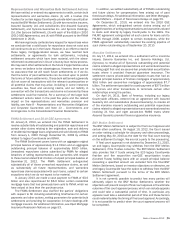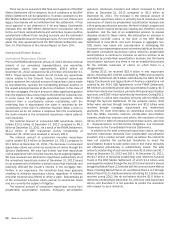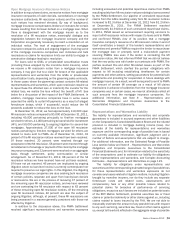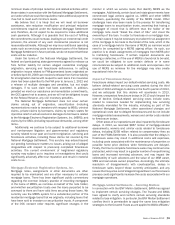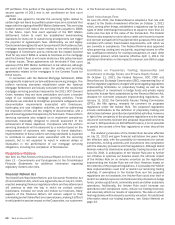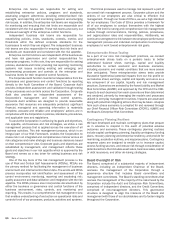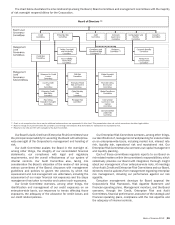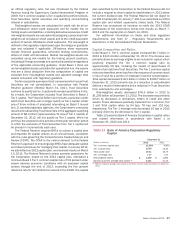Bank of America 2012 Annual Report Download - page 62
Download and view the complete annual report
Please find page 62 of the 2012 Bank of America annual report below. You can navigate through the pages in the report by either clicking on the pages listed below, or by using the keyword search tool below to find specific information within the annual report.60 Bank of America 2012
HFI portfolios. This portion of the agreement was effective in the
second quarter of 2011 and is not conditioned on final court
approval.
BANA also agreed to transfer the servicing rights related to
certain high-risk loans to qualified subservicers on a schedule that
began with the signing of the BNY Mellon Settlement. This servicing
transfer protocol will reduce the servicing fees payable to BANA
in the future. Upon final court approval of the BNY Mellon
Settlement, failure to meet the established benchmarking
standards for loans not in subservicing arrangements can trigger
the payment of agreed-upon fees. Additionally, we and legacy
Countrywide have agreed to work to resolve with the Trustee certain
mortgage documentation issues related to the enforceability of
mortgages in foreclosure and to reimburse the related Covered
Trust for any loss if BANA is unable to foreclose on the mortgage
and the Covered Trust is not made whole by a title policy because
of these issues. These agreements will terminate if final court
approval of the BNY Mellon Settlement is not obtained, although
we could still have exposure under the pooling and servicing
agreements related to the mortgages in the Covered Trusts for
these issues.
In connection with the National Mortgage Settlement, BANA
has agreed to implement certain additional servicing changes. The
uniform servicing standards established under the National
Mortgage Settlement are broadly consistent with the residential
mortgage servicing practices imposed by the 2011 OCC Consent
Order; however, they are more prescriptive and cover a broader
range of our residential mortgage servicing activities. These
standards are intended to strengthen procedural safeguards and
documentation requirements associated with foreclosure,
bankruptcy, and loss mitigation activities, as well as addressing
the imposition of fees and the integrity of documentation, with a
goal of ensuring greater transparency for borrowers. These uniform
servicing standards also obligate us to implement compliance
processes reasonably designed to provide assurance of the
achievement of these objectives. Compliance with the uniform
servicing standards will be assessed by a monitor based on the
measurement of outcomes with respect to these objectives.
Implementation of these uniform servicing standards is expected
to contribute to elevated costs associated with the servicing
process, but is not expected to result in material delays or
dislocation in the performance of our mortgage servicing
obligations, including the completion of foreclosures.
Regulatory Matters
See Item 1A. Risk Factors of this Annual Report on Form 10-K and
Note 13 – Commitments and Contingencies to the Consolidated
Financial Statements for additional information regarding
regulatory matters and risks.
Financial Reform Act
The Dodd-Frank Wall Street Reform and Consumer Protection Act
(Financial Reform Act), which was signed into law on July 21, 2010,
enacted sweeping financial regulatory reform and has altered and
will continue to alter the way in which we conduct certain
businesses, increase our costs and reduce our revenues. Many
aspects of the Financial Reform Act remain subject to final
rulemaking and will take effect over several years, making it difficult
to anticipate the precise impact on the Corporation, our customers
or the financial services industry.
Debit Interchange Fees
On June 29, 2011, the Federal Reserve adopted a final rule with
respect to the Durbin Amendment effective on October 1, 2011
which, among other things, established a regulatory cap for many
types of debit interchange transactions to equal no more than 21
cents plus five bps of the value of the transaction. The Federal
Reserve also adopted a rule to allow a debit card issuer to recover
one cent per transaction for fraud prevention purposes if the issuer
complies with certain fraud-related requirements, with which we
are currently in compliance. The Federal Reserve also approved
rules governing routing and exclusivity, requiring issuers to offer
two unaffiliated networks for routing transactions on each debit
or prepaid product, which became effective April 1, 2012. For
additional information on the impact to revenue, see CBB on page
34.
Limitations on Proprietary Trading; Sponsorship and
Investment in Hedge Funds and Private Equity Funds
On October 11, 2011, the Federal Reserve, OCC, FDIC and
Securities and Exchange Commission (SEC), representing four of
the five regulatory agencies charged with promulgating regulations
implementing limitations on proprietary trading as well as the
sponsorship of or investment in hedge funds and private equity
funds (the Volcker Rule) established by the Financial Reform Act,
released for comment proposed implementing regulations. On
January 11, 2012, the Commodity Futures Trading Commission
(CFTC), the fifth agency, released for comment its proposed
regulations under the Volcker Rule. The proposed regulations
include clarifications to the definition of proprietary trading and
distinctions between permitted and prohibited activities. However,
in light of the complexity of the proposed regulations and the large
volume of comments received (the proposal requested comments
on over 1,300 questions on 400 different topics), it is not possible
to predict the content of the final regulations or when they will be
issued.
The statutory provisions of the Volcker Rule became effective
on July 21, 2012 and gave financial institutions two years from
the effective date, with the possibility for extensions for certain
investments, to bring activities and investments into compliance
with the statutory provisions and final regulations. Although Global
Markets exited its stand-alone proprietary trading business as of
June 30, 2011 in anticipation of the Volcker Rule and to further
our initiative to optimize our balance sheet, the ultimate impact
of the Volcker Rule on us remains uncertain as the regulations
implementing the Volcker Rule are not final. However, based on
the contents of the proposed regulations, it is possible the Volcker
Rule implementation could limit or restrict our remaining trading
activities. If exemptions in the Volcker Rule and the proposed
regulations are not available, the Volcker Rule could also limit or
restrict our ability to sponsor and hold ownership interests in hedge
funds, private equity funds, commodity pools and other subsidiary
operations. Additionally, the Volcker Rule could increase our
operational and compliance costs, reduce our trading revenues,
and adversely affect our results of operations. The date on which
final regulations will be issued is currently uncertain. For additional
information about our trading business, see Global Markets on
page 44.



